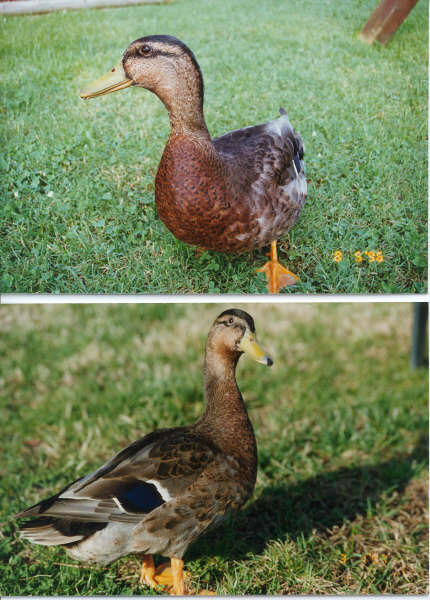| Growth Cycle in Mallards

Two Weeks: Light-colored "juvenile down" grows in among the natal (birth) down. The natal down is usually dark yellow. Three to Four Weeks: The natal down fades in color. Proportionally more of the duck is covered in juvenile down. Lighter yellow feathers appear. The body of the duck has also been growing in length. The first juvenile feathers start to sprout along the ducks' side, tail and back and replace the natal down. These feathers are much better at insulating and protecting the duckling than its down was. Ducklings begin to "tip-up" to feed and they will bathe and start to preen themselves. Five Weeks: Feathers are rich brown in color. Six Weeks: Juvenile feathers have usually grown in completely. Wings are the last appendage to develop, and even at five weeks of age, they lag behind the rest of the body's growth. The four to six week period is usually referred to as the "ugly duckling" stage. Patches of worn, faded down are still present and sharply contrast with the new juvenile feathering. The feet and bill are large and adultlike but the wings are small. At this age, the mallard is almost fully grown. Surplus nutrients are channeled to the wings because growth has slowed in other areas of the duck. Eight Weeks: Mallards will repeatedly exercise their wings by flapping them. This will strengthen the pectoral muscles which enable them to fly. Once completely grown, blood supply is shut off and the feathers can firmly attach to the bones of the wing. Mallards can usually take their first flight around this time. Adult feathers must be replaced each year due to wear and damage. Adults molt in the summer, after breeding and nesting. The male will shed his flight feathers and will continue molting until he loses his green head feathers and becomes a camouflaged henlike body coloring. Ducks will replace their wing feathers once and their body feathers twice.
Written by:
Michelle Shames
Pictures courtesy of Michelle Shames of her mallard duck Petey @1/13/03
For use on the Gander Gab |  Free Forum Hosting
Free Forum Hosting